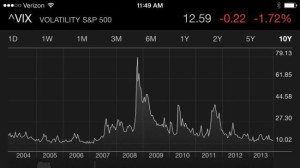The Nasdaq index’s year-to-date gain of more than 33% is far outpacing the Dow Jones Industrial Average’s rise of 23% and the 27% rally in the S&P 500. Fueling the Nasdaq’s rally is a hunt by investors to find faster-growing companies in an economy that has yet to show a sustained acceleration.
But unlike the Dow and the S&P 500, which are far into record territory, the Nasdaq remains roughly 20% below its dot-com-era peak. The index hit its all-time high of 5048.62 on March 10, 2000. On Tuesday it closed at 4017.75, up 23 points or 0.58% for the day.
Data showed demand for home building permits jumped 6.2% in October to an adjusted annual rate of 1.034 million, the highest level in more than five years. Economists had projected a rise to a pace of 930,000. The S&P/Case-Shiller 20 City home-price index for September rose 13.3% on the year, slightly better than expectations for it to show a rise of 13%.
The Conference Board’s consumer-confidence index for November unexpectedly fell to 70.4 from 71.2 in October. Economists expected the index to show a rise to 73.0. The Conference Board said uncertainty about future employment and income prospects could make this a challenging holiday season for retailers.
What do you think is driving the markets now?

VS.

An indicator of Fear is the VIX Index (Implied volatility and/or the amount of “insurance premium” implied by the price of options), which is near its all time lows, as in the chart below (implying investors are complacent or less fearful):
Below is a post from the Chief Economist of First Trust, Brian Wesbury, talking about QE, that resonates with my own thinking on this subject:
The most frequent question we get lately is “what happens to long-term interest rates when quantitative easing ends?” Many analysts argue that the Federal Reserve is buying and holding a huge share of Treasury debt and once QE ends other buyers will suddenly have to absorb more. This will cause interest rates to soar, bust the housing market, undermine stocks, and possibly cause a recession.
We disagree with this analysis in major ways. To respond, we crafted some charts which you will be able to find on our blog, here. In addition, a friend and one of our favorite economists, Scott Grannis at Calafia Beach Pundit, tackled the same topic last week. We urge you to read his take as well.
Much of what people believe about QE is mistaken. It has boosted the monetary base, but not M2. Interest rates are low because of the zero fed funds rate policy, not QE. And most importantly, despite trillions in purchases, the share of Treasury debt held by the Fed is not out of line with history.
Don’t get us wrong. We expect interest rates to move higher in the years ahead, but not because QE ends and not as quickly as the QE-bears say. Until the Fed raises short-term rates, it’s unlikely the 10-year Treasury yield will rise above 4%. QE is a signal of the Fed’s commitment to hold short-term rates near zero, not a direct driver of rates. The longer investors expect the Fed to keep rates near zero, the lower longer-term yields will be. QE itself is not as important as many think.
The Fed has not cornered the Treasury market. The Fed now owns 18% of marketable Treasury debt. This is not an unusually large share; the recent peak was 20% in 2002 and the Fed still held 17% in 2008. Borrowing exploded upward in the Panic, the Fed’s share of debt fell to 8%, but, with QE, it’s back up to 18%. If the Fed still bought $45B/month of Treasuries for the next twelve months – which is very unlikely – we estimate the Fed’s share of Treasury debt would rise to just 21%, slightly above the peak in 2002.
Interest rates have moved in the same direction as the Fed’s share of Treasury debt. Those who see QE as the driver of interest rates have a huge problem – the facts. From late 2007 through early 2009 the Fed’s share of the debt plummeted while interest rates fell. From late 2009 through early 2011, the Fed used QE to push its share back up, but interest rates trended up slightly. From early 2011 through the end of 2012, the Fed’s share of the debt gradually fell. In theory, interest rates should have risen; instead, they fell. So far this year, the Fed’s share of Treasury debt has risen while interest rates have gone up.
Don’t worry; private markets can absorb debt normally. Since 1975, the amount of marketable Treasury debt held outside the Federal Reserve (known as privately-held debt) has increased $9.3 trillion, or $242 billion per year. During this time, annual GDP averaged $8.1 trillion per year. So, on average, the private markets have absorbed Treasury debt equal to 3% of GDP, sometimes more and sometimes less.
If the Fed goes “cold turkey” on QE, but rolls over the debt it already owns, private purchasers of Treasury debt would have to absorb an amount roughly equivalent to the budget deficit, which we forecast to be about 3% of GDP in fiscal year 2014. That’s no different than the long-term average.
More likely, the Fed will taper purchases in 2014 rather than going cold turkey. Assuming the Fed bought $250 billion (about $20 billion per month), private markets would be left to absorb debt equal to about 1.5% of GDP. Easy peasy.
We don’t believe deficits drive interest rates, but for those who do, the idea that QE itself is the driving force behind long-term rates is seriously flawed. The Fed owns no greater share of the debt than normal, and, deficits are shrinking.
While we expect interest rates to head higher, the bottom line is that QE was never that important and ending it is not the Armageddon event that the Bearish clan wants to believe.
The S&P 500 climbed 8.91 points, or 0.5%, to 1804.76. The index is up 27% this year, on pace for its biggest annual gain since 1998, when it climbed 31%. It took more than 13 years for the Index to climb past 1,600 and this year has risen past 1,700 and now 1,800.
An accommodative Federal Reserve, paltry returns in assets such as bonds and steady expansion in corporate profits continue to draw investors to equities. Bulls say the U.S. economy’s expansion—muted as it is—stands out when compared with conditions in other parts of the globe and is liable pick up next year.
Meanwhile, individual investors appear to be regaining comfort with stocks. Mutual funds investing in U.S. shares took in a net $548 million in new cash in the week ended Wednesday, according to fund tracker Lipper, the sixth-straight week of inflows.
Thanks to fracking and shale oil production, the United States is becoming a leading producer of Oil and Gas in 2013, overtaking Russia. Some facts:
- Average oil production in October 2013 was 7.8 mbpd, 19% higher than last year.
- Rising crude supplies from North Dakota’s Bakken shale and Eagle Ford shale in Texas have helped the U.S. become the world’s largest exporter of refined fuels.
- Per EIA, Texas pumped 2.575 mbpd in June-if Texas were its own country, it would rank 15th in the world in terms of oil production.
- The U.S. met 87% of its energy needs in the first five months of 2013 and is on target to hit the highest annual rate since 1986.
- Exports are surging from 1 mbpd in 2006 to 3 mbpd recently.
- Imports are falling from a high of 14 mbpd in 2007 to under 10 mbpd recently. If you take out the re-export of refined products, the Net Imports have fallen even faster to 6 mbpd from 13 mbpd.
Can this declining U.S. net import of Oil and Gas have an impact on the U.S. dollar through its linkages to Current Account Deficits? Generally, a declining Current Account Deficit should be a tail wind for that country’s currency. Also, cheap and abundant natural gas in the U.S. is becoming a competitve advantage to begin bringing offshore production back onshore, which can further impact trade flows and deficits.
Can the once mighty U.S. dollar regain its footing again?



